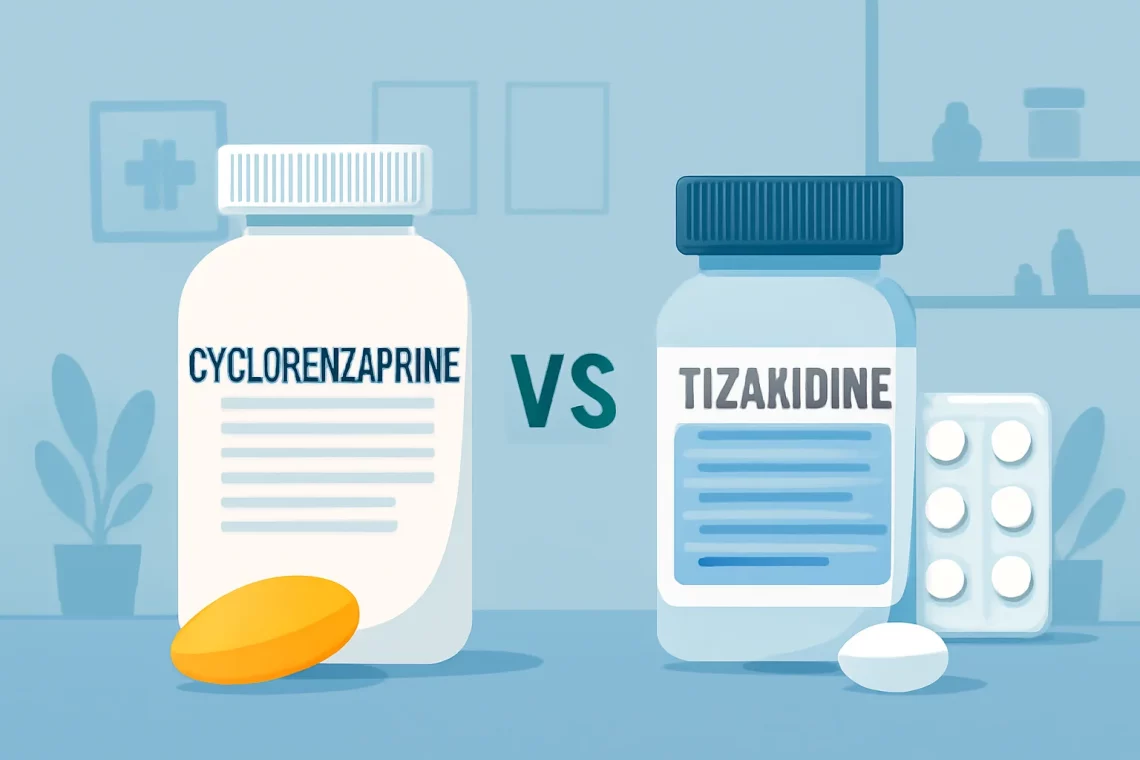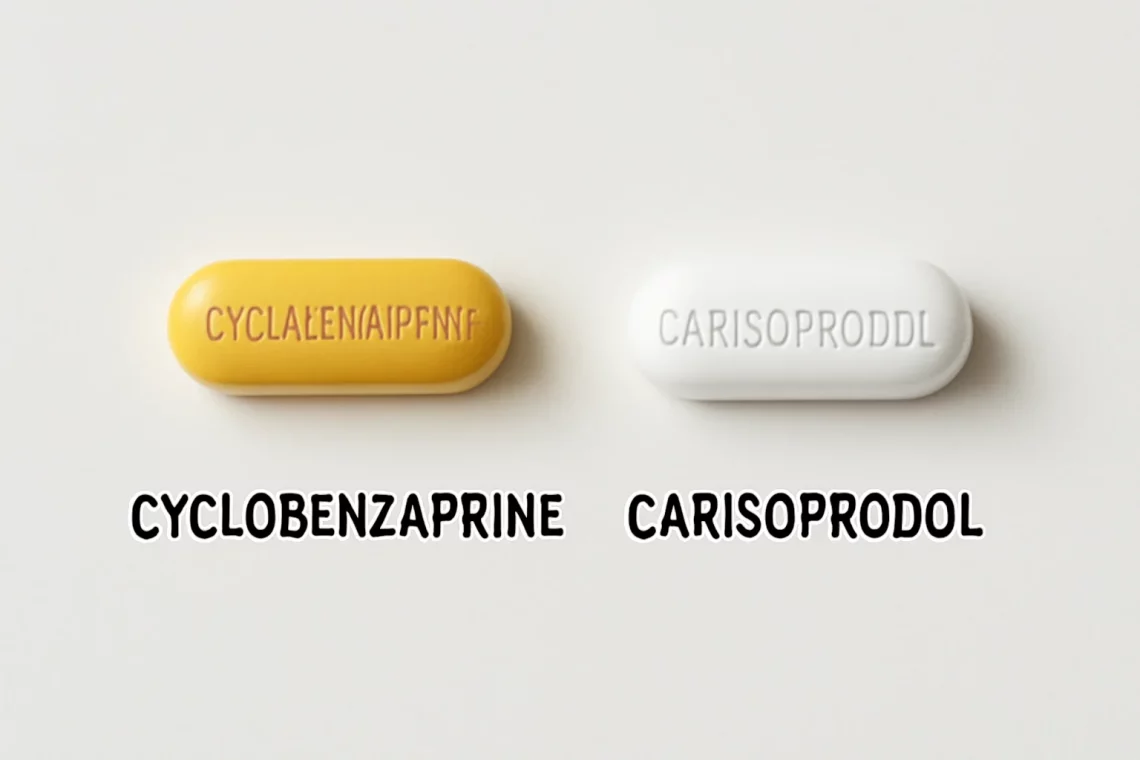-
Cyclobenzaprine vs Tizanidine: Key Differences and Uses Explained
Cyclobenzaprine and tizanidine are two medications commonly prescribed to manage muscle spasms and associated discomfort. Both belong to the category of muscle relaxants but differ significantly in their mechanisms of action, indications, and side effects. Understanding these differences is crucial for healthcare providers and patients alike, as it can influence treatment choices and outcomes. Cyclobenzaprine is primarily used for short-term relief of muscle spasms, often resulting from acute musculoskeletal conditions. It works by acting on the central nervous system, helping to reduce muscle tightness and discomfort. On the other hand, tizanidine operates differently by acting as an alpha-2 adrenergic agonist, which decreases spasticity by inhibiting the release of excitatory neurotransmitters.…
-
Cyclobenzaprine vs Valium: Understanding Their Differences and Uses
Cyclobenzaprine and Valium are two medications that are often discussed in the context of managing muscle spasms and anxiety. As individuals seek effective solutions for various health issues, understanding the differences, uses, and potential side effects of these medications becomes essential. Both drugs have unique mechanisms of action and are prescribed for different conditions, yet they can sometimes be confused due to their similar effects on the body. In this landscape of pharmaceuticals, it is crucial for patients and healthcare providers alike to make informed decisions regarding treatment options. Knowledge of how these medications interact with the body, their indications, and contraindications can significantly influence patient outcomes. As we delve…
-
Cyclobenzaprine vs Skelaxin: Comparing Muscle Relaxants for Pain Relief
Cyclobenzaprine and Skelaxin are both widely used medications in the realm of muscle relaxants. These medications play a crucial role in alleviating muscle spasms and discomfort, often resulting from injuries, overexertion, or conditions such as fibromyalgia. Understanding the differences, benefits, and potential side effects of these drugs is essential for patients considering their use. The choice between Cyclobenzaprine and Skelaxin can significantly influence treatment outcomes, as each medication has its unique properties and indications. As muscle relaxants, they act on the central nervous system to reduce muscle tension and enhance mobility, which can be particularly beneficial in rehabilitation settings. Both medications have their advocates and specific circumstances under which they…
-
Cyclobenzaprine vs Soma: Understanding Their Differences and Uses
Cyclobenzaprine and Soma are two medications commonly used for muscle relaxation and pain relief. Both drugs have become popular choices for individuals seeking relief from musculoskeletal conditions, but they differ in composition, mechanism of action, and potential side effects. Understanding these differences is crucial for patients and healthcare providers when determining the most appropriate treatment option. While cyclobenzaprine is often prescribed for short-term relief of muscle spasms, Soma, or carisoprodol, has its unique characteristics that set it apart. As healthcare continues to evolve, more individuals are seeking non-invasive solutions for muscle pain and spasms, leading to an increase in the use of these medications. However, the road to recovery can…
-
Cyclobenzaprine vs Chlorzoxazone: Key Differences and Uses Explained
Cyclobenzaprine and chlorzoxazone are both medications commonly used to treat muscle spasms and discomfort. Although they serve similar purposes, these two drugs possess distinct properties, mechanisms of action, and side effects profiles. Understanding the nuances between cyclobenzaprine and chlorzoxazone can empower patients and healthcare providers to make informed decisions regarding treatment options. Muscle spasms can arise from various conditions, including injuries, overuse, or underlying medical issues. The sensation of tightness, pain, or restricted movement can significantly impact daily life, leading individuals to seek relief through medication. While both cyclobenzaprine and chlorzoxazone are classified as muscle relaxants, they differ in their chemical structure and how they interact with the nervous system.…
-
Cyclobenzaprine vs Carisoprodol: Which Muscle Relaxant is Better?
Cyclobenzaprine and Carisoprodol are two medications commonly prescribed for the treatment of muscle spasms and discomfort associated with musculoskeletal conditions. Both belong to a class of drugs known as muscle relaxants, which work by affecting the central nervous system to alleviate pain and improve mobility. While they share some similarities in their therapeutic use, they also have distinct differences in terms of mechanism of action, side effects, and duration of use. In an era where muscle-related issues are increasingly prevalent due to sedentary lifestyles and physical stressors, understanding these medications can empower patients and healthcare providers alike. Muscle relaxants like cyclobenzaprine and carisoprodol have become important components in managing pain…
-
Lyrica vs Baclofen: A Comprehensive Comparison of Uses and Effects
Lyrica and Baclofen are two medications often used to manage different types of pain and neurological conditions. Each has distinct mechanisms of action, benefits, and side effects, making them suitable for various patients and conditions. Lyrica, the brand name for pregabalin, primarily targets neuropathic pain and seizures, while Baclofen is a muscle relaxant predominantly used for spasticity related to neurological disorders. Understanding the differences between these two medications is crucial for patients and healthcare providers in order to choose the most appropriate treatment options. The decision to use Lyrica or Baclofen can be influenced by factors such as the specific condition being treated, the patient’s medical history, and the potential…
-
Cyclobenzaprine vs Baclofen: Which Muscle Relaxant is Right for You?
Muscle relaxants are widely used to alleviate discomfort and facilitate recovery in various musculoskeletal conditions. Among the many options available, cyclobenzaprine and baclofen are two medications that often come up in discussions regarding effective muscle relaxation therapies. Each of these drugs possesses unique properties, and understanding their differences, uses, and potential side effects can help patients and healthcare providers make informed decisions. As more individuals seek relief from muscle spasms and pain, it is crucial to explore the mechanisms of action, indications, and contraindications of these medications. While both cyclobenzaprine and baclofen can provide significant benefits, their distinct pharmacological profiles mean they may be better suited for different patient populations…
-
Cyclobenzaprine vs Zanaflex: Understanding Their Differences and Uses
Cyclobenzaprine and Zanaflex are two medications commonly prescribed for muscle relaxation and pain relief. As muscle relaxants, they serve to alleviate discomfort associated with muscle spasms and musculoskeletal conditions. While both medications share a similar purpose, their mechanisms of action, side effects, and use cases can differ significantly. Understanding these differences is crucial for both patients and healthcare providers to make informed decisions regarding treatment options. In a landscape where pain management is paramount, the choice between Cyclobenzaprine and Zanaflex can be pivotal in achieving effective relief and improving patients’ quality of life. This article delves into the nuances of these two medications, exploring their distinct characteristics, benefits, and potential…
-
Cyclobenzaprine vs Robaxin: Key Differences and Uses Explained
Cyclobenzaprine and Robaxin are two commonly prescribed muscle relaxants that are used to alleviate muscle spasms and discomfort caused by musculoskeletal conditions. As patients seek effective relief from pain and tension, understanding the differences between these medications becomes crucial. Both drugs belong to different classes of muscle relaxants and have unique mechanisms of action, side effects, and potential interactions. Cyclobenzaprine is often utilized for short-term treatment of muscle spasms, providing quick relief for patients who are recovering from injuries or dealing with acute pain. Its sedative properties can be beneficial in promoting rest, but they also raise considerations regarding daytime drowsiness and impairment. On the other hand, Robaxin, or methocarbamol,…






































